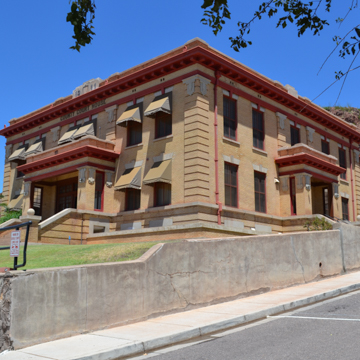With Arizona statehood looming in the early 1900s, conflicts erupted between the farmers of the Gila Valley in west-central Graham County and the more prosperous mining interests in the county’s mountainous eastern region. At issue was the equitable collection of taxes and distribution of government funds, which ultimately led to the creation of Greenlee County. Arizona’s fourteenth county, and the final one added prior to statehood, Greenlee became a reality only after it agreed to pay off Graham County’s entire existing bond debt and to purchase new school bonds.
Named after Mason Greenlee, an early pioneer, the new county consisted mostly of rugged forested mountains in the north, and farms and ranches in the south, with one of the largest copper ore bodies in the world in between. The new county’s courthouse was built on land donated by developer Henry Hill in his Hill’s Addition. The architect was E.C. Heck of Clifton, with Otto Kroeger of El Paso serving as general contractor. The $43,000 contract for construction was awarded November 16, 1911, with completion in the fall of 1912. A freestanding jail building was added to the north side soon after, as had occurred at the Gila County Courthouse in Globe two years earlier.
The courthouse walls are tan brick and the west and south facades are nearly identical, each with an entry portico and stairway. Inscribed in the raised parapet above the south entry portico is the year construction began, with the numerals 19 and 11 separated by an incised representation of the scales of justice. Brackets support a continuous extended cornice separating the lower two stories from the parapet above. The foundation walls and corner pilasters, along with the pilasters flanking each entry portico, feature deep horizontal joints. Bas-relief geometric details adorn the pilaster capitals.
In 1999 the building underwent a one million dollar renovation at the direction of Greenlee County Superior Court Judge Allen G. Minker, which led the American Public Works Association to name the refurbished courthouse a Public Works Project of the Year. The exterior remains unchanged on the north, south (primary), and east facades; it is most altered on the interior. A late Modern concrete block annex to the east, designed by Gresham Larson Architects of Tucson, was completed circa 1980. The courthouse was not included in the 1990 listing of the Clifton Townsite Historic District in the National Register of Historic Places.
References
Patton, James M. History of Clifton. Clifton, AZ: Greenlee County Chamber of Commerce, 1977.
Rotstein, Arthur (Associated Press). “Arizona’s Southern Region: Historic Clifton.” AZ Central.com. Accessed September 1, 2017. http://archive.azcentral.com/.
Zindel, Udo. Landscape Evolution in the Clifton-Morenci Mining District, Arizona, 1872-1986. Master’s thesis, Arizona State University, 1987.





